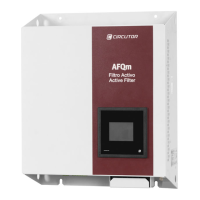39
Instruction Manual
AFQm
Individual distortion rate (U
n
% or I
n
%): A ratio in % between the RMS value of the voltage or
harmonic current (Un or In) and the RMS value of the fundamental component (U
1
or I
1
).
% =
1
∗100
=
�
1
2
+
2
2
+
3
2
+
5
2
+ ⋯
=
�
1
2
+
2
2
+
3
2
+
5
2
+ ⋯
(
)
% =
�
2
2
+
3
2
+
5
2
+ ⋯
1
(
)
% =
�
2
2
+
3
2
+
5
2
+ ⋯
1
=
−
(
)
=
[
ℎ
∗
∗()
]
=
% =
1
∗100
% =
1
∗100
=
�
1
2
+
2
2
+
3
2
+
5
2
+ ⋯
=
�
1
2
+
2
2
+
3
2
+
5
2
+ ⋯
(
)
% =
�
2
2
+
3
2
+
5
2
+ ⋯
1
(
)
% =
�
2
2
+
3
2
+
5
2
+ ⋯
1
=
−
(
)
=
[
ℎ
∗
∗()
]
=
Equation 1:Individual distortion rate
True root mean square value (TRMS): The square root of the sum of the squares of all components
forming the wave.
% =
1
∗100
% =
1
∗100
=
�
1
2
3
5
2
2
2
2
(
)
% =
�
2
2
+
3
2
+
5
2
+ ⋯
1
(
)
% =
�
2
2
+
3
2
+
5
2
+ ⋯
1
=
−
(
)
=
[
ℎ
∗
∗()
]
=
Equation 2:True root mean square value
Harmonic content: The difference between the total voltage or current and the corresponding
fundamental value.
Harmonic distortion rate (THD): The ratio between the RMS value of the harmonic content of the
voltage and/or current and the value of the fundamental component.
% =
1
∗100
% =
1
∗100
=
�
1
2
+
2
2
+
3
2
+
5
2
+ ⋯
=
�
1
2
+
2
2
+
3
2
+
5
2
+ ⋯
(
)
% =
�
2
3
5
(
)
% =
�
2
2
+
3
2
+
5
2
+ ⋯
1
=
−
(
)
=
[
ℎ
∗
∗()
]
=
% =
1
∗100
% =
1
∗100
=
�
1
2
+
2
2
+
3
2
+
5
2
+ ⋯
=
�
1
2
+
2
2
+
3
2
+
5
2
+ ⋯
(
)
% =
�
2
2
+
3
2
+
5
2
+ ⋯
1
(
)
% =
�
2
3
5
=
−
(
)
=
[
ℎ
∗
∗()
]
=
Equation 3:Harmonic distortion rate.
Total demand distortion (TDD): Ratio between the effective value of the residual harmonic current
and the value of the maximum demand current.
% =
1
∗100
% =
1
∗100
=
�
1
2
+
2
2
+
3
2
+
5
2
+ ⋯
=
�
1
2
+
2
2
+
3
2
+
5
2
+ ⋯
(
)
% =
�
2
2
+
3
2
+
5
2
+ ⋯
1
(
)
% =
�
2
2
+
3
2
+
5
2
+ ⋯
1
=
−
(
)
=
[
ℎ
∗
∗()
]
=
(
)
% =
�
2
2
+
3
2
+
5
Equation 4:Total demand distortion.
Where I
L
, is defined as the average of the maximum demand currents in the last 12 months, measured
monthly. If this value is not available, the nominal line current can be used.
4.1.2.- MOST COMMON HARMONICS
Table 18 lists the most common harmonic generator loads and the wave shape of the current they
consume, as well as their harmonic spectrum.

